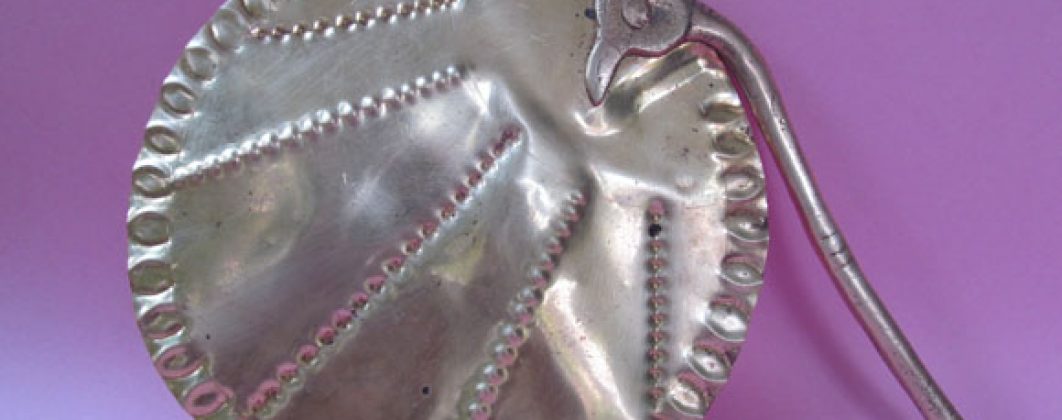
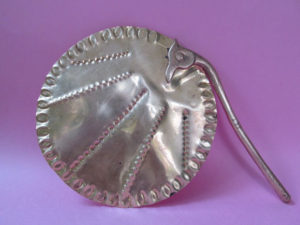
I am going to present to you an antique hand-held brass fan which I have collected recently that was used by a rich landlord during the Zamindari system in pre-independence India. This beautiful brass fan is acquired from a gentleman by name Adinarayanan whose great grandfather was working as a chief accountant for a wealthy landlord in present Tamil Nadu state,India somewhere in the pre-independence era or the early 19s. It was given as a gift by the landlord to his Chief accountant for the services rendered to him. In the days of Rajas and Zamindars, it is a common practice to bestow gifts to the devoted persons as a mark of appreciation and honor. As it was heavy, the owner would have his servant to do the fanning during important social and cultural functions as it was considered a mark of status. It has been in Shri Adinarayana’s family for more than 3 generations.
The Design Of The Brass Hand-held Fan
This hand-held brass fan is designed to give appearance as a fan made out of Palmyra palmtree leaves which is used very common in those days and even now in rural areas of India as it is very handy, light and inexpensive. The fan is round in shape and the handle is designed to look like a peacock neck with the beak clutching the fan. There is a stitching design joining the leaves of the fan.There is a border design all around the periphery of the fan resembling the stitching the borders with a design to prevent the leaves from damage during handling.The whole fan is so ingeniously designed to combine esthetics with functionality.
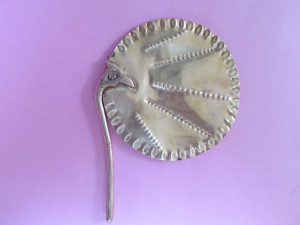

The History And Evolution Of The Fan
Man is always in constant search of comfort and happiness. He has devised tools and implements that give him the desired level of comfort and a sense of feeling good. Man has developed ingenious methods to counter the vagaries of nature that make him uncomfortable and developed ways and means to be cozy and comfy.
He invented the primitive umbrella to protect himself from rain and covered himself with animal skin and cloth made out of plant material. To ward off oppressive heat and sultry weather, the primitive man made hand-held fans with dried leaves to create air movement around him to get relief from his discomfort. The very origin of primitive fans most likely was to hasten up the burning of fire and also to chase away the insects that disturbed the man and eventually acquired a prestigious place. For ages, long handled hefty fans were ritualistic symbols of supremacy, the privilege of Kings, Pharaohs and Priests. Even in present times, fans of this magnitude are ceremonially carried in formal religious processions.
The humble primitive fans have taken a different avatars as man improvised different verities with different materials as civilization progressed. He started making fans with feathers, ostrich plumes, ,bamboo, cane, palm leaves, roots, silk and cotton cloth, ivory, wood , fine metals and with as fragile as a butterfly`s wings. To enhance his comfort level, he developed larger fans that can be held and swung by other individuals like his servants and slaves. He also developed remote fanning device like Pankha that can be fixed above him and can be pulled by a rope held by a person sitting in a remote place. With the invention of electricity, man used this wonder power to create the present electric fan that provides him air by pressing a button. The simple fan has taken a very colorful journey through out the growth of civilization by serving the need of a common man to, nobles, kings, queens and gods as well. It became part of religious rituals and a mark of social status symbol.
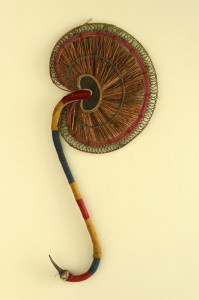
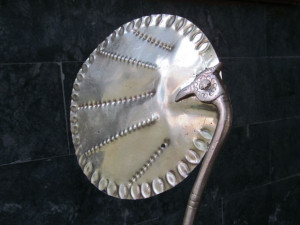
Hand Held Fans – My Childhood Memories
It is considered as a good deed if you gift to someone a fan during the summer seasons of India. In my village Someswaram, Andhra Pradesh, India, Sri Rama Navami, the birth day of Lord Rama is celebrated in great devotion. Normally, this festival falls in the summer months of April or May. As a boy, I used to attend this festival being celebrated in our village temple without fail since I used to get a palm leaf fan and a mango fruit free.
In our area, it is a strong belief that if any one gifts a fan and a mango fruit during the summer season they acquire lot of divine blessings. Imagine someone doing that now in this modern age. Picture yourself walking up to your friend or relative and gifting them a fan and one single mango fruit? How do you think they would react?
Anyways, getting back to the past, sometimes we used to get two or three fans also if there are more than one donor.We never had electricity in our house and the only source of getting some air is by these palm leaf fans.It is a regular even practice in our home that preparation of bed for the night include a leaf fan next to the pillow. We used to do self-fanning with our hands alternately till the fan automatically dropped out once sleep set in.
Truly Multi-Purpose!
This fan has a multi-purpose use. My mother used to use these fans for airing the charcoal stove to get the required flame for cooking food. My grandfather used these fans to chase away the flies during his mid-day mango feasting session.My grandfather was a mango lover and during the season he used to eat 10 to 12 fruits daily during the afternoons after soaking the mangoes in a large brass vessel for an hour to cool them and wash them before eating.
Hand-held Fans In Religious Ceremonies
One of the devotional services rendered during Pooja ceremony to the Gods is Vinjamaramseva. Vinjamaramin Sanskrit means fan. After the Abhishekam (ceremonial bath), Harati (ceremonial camphor flame circled around the god) and Naivedyam(offering of food to the gods), Vinjamaramseva (fanning the god) is done in a traditional pooja.
It is written in Aagamasastra (the scriptures that describe the religious pooja ceremony) how to do a traditional pooja ceremony to different Gods and Goddesses.One of the most important rituals is to wave the fan in front of the God to circulate air around him.This is done in two ways:
the hand-held fans generally made out of wood or bamboo covered with silk cloth with frills around it
(or)
With onemade out of metals like brass,silver and gold or with peacock feathers.
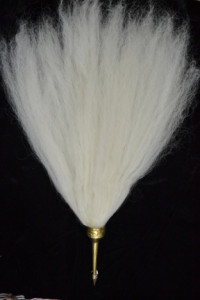
.
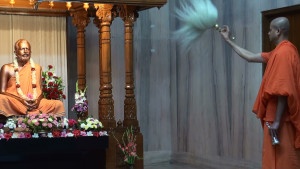
There is another type of fan called as chamaram, made out of the hair from the tail of a yak. Chamaram is of a different shape.One end of the Yak hair is inserted into a handle made out of a metal.The other end of the hair is spread out loose.These types of fans are used in the religious Pooja ceremonies of Hindu, Buddhist and Jain temples as well.
The Yak tail hair is considered as sacred.The Yak is an animal belonging to cattle family with long hair found in the Himalayan region of southern part of the central Asia,Tibet, Mongolia and as north as Russia.
Pankha is a hanging fan invented by Britishers during their British rule in India to have a constant supply of air to get relief from the oppressive heat in India. Pankha is made in a rectangular shape with a combination of wood and cloth, with or without frills, hung to a ceiling with ropes and pulleys and pulled with a rope to create fanning movement. The pankhas subsequently became a common sight in royal and aristocratic families,in the offices of the Britishers and high ranking officers. The rope is pulled by a rope-puller who sits outside the pankha room and pulls the rope repeatedly in a front and back motion. During the British rule, there was a permanent post called “Pankha Puller”and the person holding that job was a proper government employee in many offices. You must have seen something similar in old Hindi and Telugu movies.
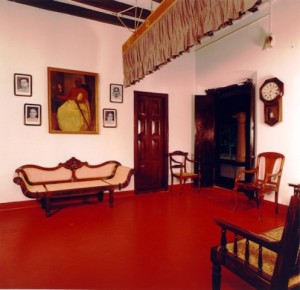
I had this wonderful experience of seeing a Pankha being pulled by a peon in a judicial court. I completed my class 7(seventh standard, then known as 2nd form) in a town called Peddapuram in Andhra Pradesh in the year 1953 staying in the house of my maternal uncle Shri. Rajapantulu. My uncle used to work for a lawyer and he used to be in the court during the court timings between10.00 AM to 5.00 PM.
If I had to see him for any purpose, I used to go to the court. The court was a huge British type of building with high ceiling and there used to be a Pankha on the ceiling above the place where the judge sits.There used to be apankha puller, an old man with official peon uniform which consisted of a turban, white trouser or dhoti and a white closed neck top, a cotton belt around his waist and a wide cotton belt across his chest resting on his left shoulder and draping on to the right side of the waist holding a brass rectangular plate that is inscribed with the name of his office.
Certain Interesting FactsAbout Hand-held Fans
– Christopher Columbus brought a feather fan,among other items from newly discovered America and gifted it to Queen Elizabeth.
– There is a museum dedicated to fans in 12 Crooms Hill, Greenwich,London SE10 8ER..
-Even in present times,fans of large size are ceremonially carried in Christian papal processions.
So that’s the story of the fan that I acquired. If you have any memories of using one or seeing one used in the days back then, do share your experience or memory of it. Would love to hear from you.

Copyright © 2021 YK Antiques Home Museum
2 Responses
Thank you for sharing your knowledge about this fan and Pankha in general.
I too have one of these fans, also with the peacock head handle but without the ‘stitching’ on the leaf, and was told it was used in a Hindu Temple. Do you think this is correct?
Thank you for writing to us. Glad to know that you have a similar one as well. Such fans are mostly meant for ceremonial use. Their use isn’t limited to temples alone. Also, they are not meant for daily functional use. Hope that helps.